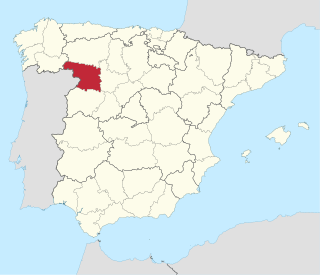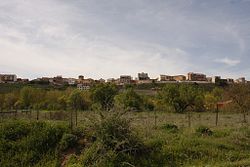
The Douro is the highest-flow river of the Iberian Peninsula. It rises near Duruelo de la Sierra in the Spanish province of Soria, meanders south briefly then flows generally west through the northern part of the Meseta Central in Castile and León into northern Portugal. Its most plentiful tributary is the right-bank Esla river. At Douro's mouth at Porto, the second largest city of Portugal, the river meets the Atlantic Ocean.

Valladolid is a province of northwest Spain, in the central part of the autonomous community of Castile and León. It has a population of 520,716 people in a total of 225 municipalities, an area of 8,110 km2 (3,130 sq mi) and a population density of 64.19 people per km2.

Zamora is a province of western Spain, in the western part of the autonomous community of Castile and León. It is bordered by the provinces of Ourense, León, Valladolid, and Salamanca, and by Portugal.

Tempranillo is a black grape variety widely grown to make full-bodied red wines in its native Spain. Its name is the diminutive of the Spanish temprano ("early"), a reference to the fact that it ripens several weeks earlier than most Spanish red grapes. Tempranillo has been grown on the Iberian Peninsula since the time of Phoenician settlements. It is the main grape used in Rioja, and is often referred to as Spain's noble grape. The grape has been planted throughout the globe's wine regions.

Aranda de Duero is a city and municipality, capital of the Ribera del Duero comarca, in the south of the province of Burgos, in Castile and León, Spain. It has a population of roughly 33,000 people and lies on the River Duero. The closest international airport is Madrid Barajas.

Peñafiel is a town in the Valladolid Province and the greater autonomous community of Castile and León, Spain. It is best known for the Peñafiel Castle and for its medieval square used for bullfights and named "Plaza del Coso". The square is surrounded by private homes, but since medieval times the rights to use their windows, balconies and doorways during bullfights are owned by the town, which auctions them to the highest bidders.

Ribera del Duero is a Spanish Denominación de Origen Protegida (DOP) located in the country's northern plateau and is one of eleven 'quality wine' regions within the autonomous community of Castile and León. It is also one of several recognised wine-producing regions to be found along the course of the Duero river.
Milagros is a Spanish village and municipality in the province of Burgos, part of the autonomous community of Castile and León. It has a population of approximately 502 people and is 10 km from Aranda de Duero. Milagros is in the comarca and wine region of the Ribera del Duero.

Spanish wine includes red, white, and sparkling wines produced throughout the country. Located on the Iberian Peninsula, Spain has over 1.2 million hectares planted in wine grapes, making it the most widely planted wine-producing nation, but the second largest producer of wine in the world, behind Italy and ahead of France and the United States. This is due, in part, to the very low yields and wide spacing of the old vines planted on the dry soils found in some of the Spanish wine regions. The country is ninth in worldwide consumption with Spaniards drinking, on average, 21.6 litres per person a year. The country has an abundance of native grape varieties, with over 400 varieties planted throughout Spain, though 88 percent of the country's wine production is from only 20 grapes — including the reds Tempranillo, Bobal, Garnacha, and Monastrell; the whites Albariño, Airén, Verdejo, Palomino, and Macabeo; and the three Cava grapes Parellada, Xarel·lo, and Macabeo.

A Rúa is a mostly rural Galician municipality in the comarca of Valdeorras, eastern province of Ourense, Spain, 101 km (63 mi) from the provincial capital, Ourense. An inhabitant of the area is known as a Rués.
The N-122 is a highway in Spain. It connects Valladolid and Zaragoza to the Portugal–Spain border, where it connects to the A4 motorway (Portugal), this section was formerly the IP-4 and is now part of the European route E82 to Matosinhos. The border is formed by the Rio Macãs it heads east crossing the Esla river to Zamora and the Duero river valley. The N-630 crosses to the north and south.

Villatuelda is a Spanish village and municipality in the province of Burgos, part of the autonomous community of Castile and León. It has a population of approximately 60 people and it is 30 km from Aranda de Duero.

The Ribera del Duero is a comarca or district located at the southern tip of the province of Burgos, part of the Spanish autonomous community of Castile and León. The capital of the Ribera del Duero comarca or district is the town of Aranda de Duero.

Castrillo de la Vega is a Spanish town and municipality in the south of the province of Burgos, in the Ribera del Duero wine region. It has a population of roughly 657 people. The post code for the town is 09391. The closest airport is in Valladolid.

La Horra is a Spanish town and municipality in the south of the province of Burgos, in the Ribera del Duero wine region and comarca.

Nava de Roa is a municipality and town located in the municipality of Ribera del Duero, province of Burgos, Castile and León, Spain. It is located 92 km from Burgos, 26 km from Aranda de Duero, and 70 km from Valladolis. According to the 2004 census (INE), the municipality has a population of 246 inhabitants.

Morales del Vino is a municipality located in the province of Zamora, Castile and León, Spain. According to the 2007 census (INE), the municipality has a population of 2,345 inhabitants.

Albillo or Albillo Real is a white Spanish wine grape variety planted primarily in the Ribera del Duero region, and also in Madrid, Ávila and Galicia. The grape has mostly neutral flavors with a light perfume aroma. It has a high glycerol index which confers smoothness to the wines.
Valtiendas is a Spanish geographical indication for wines referred to legally as Vino de calidad con Indicación Geográfica. This is one step below the mainstream Denominación de Origen quality wines and one step above the less stringent Vino de la Tierra table wines on the quality ladder.

The gastronomy of the province of Valladolid comprises the meals, their preparation, and the culinary habits of the province of Valladolid. It is based on barbecued and roast food, especially roasted Spanish cuisine. Wines of high quality highlight the meals.





















